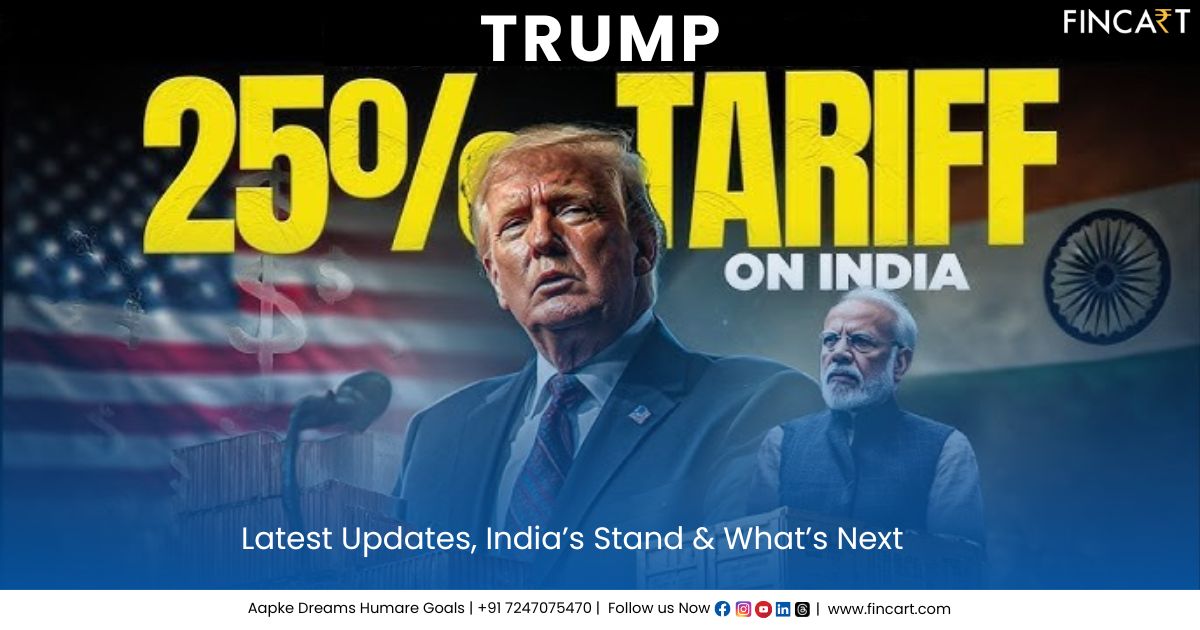On August 1, 2025, the United States imposed a 25% tariff on Indian goods—a move that has reignited tensions in global trade diplomacy and sent shockwaves through key industries.
For investors, exporters, and businesses, this isn’t just another policy update—it’s a development that could reshape trade strategies, impact sectoral growth, and influence bilateral relations between two major economies.
So, what led to this sudden tariff hike? How is India responding, and what should stakeholders watch for in the weeks ahead? Let’s break down the key developments and their wider implications.
Why Did the US Impose a 25% Tariff on India?
US President Donald Trump announced the tariffs via Truth Social on July 30, 2025, reviving a more aggressive trade stance that many thought had subsided. The announcement came with strong geopolitical undertones — including an unspecified “penalty” linked to India’s defense and energy ties with Russia.
Several factors are driving this move:
1. Rising US-India Trade Deficit
In 2024, the US goods trade deficit with India stood at $45.7 billion, a figure that has steadily grown. From Washington’s perspective, this trade imbalance suggests an unequal relationship, one that they argue justifies corrective tariffs.
2. Concerns Over India’s Trade Barriers
India’s agricultural subsidies and strict food safety regulations (SPS standards) are seen by the US as unfair trade practices that hinder American exports.
3. India’s Role in BRICS
India’s participation in BRICS — especially in discussions around alternative payment systems to the US dollar — is viewed by the US as a potential challenge to its economic leadership.
4. Russia Factor
India’s ongoing oil and defense imports from Russia have triggered US scrutiny. The proposed Russian Sanctions Act 2025 aims to penalize countries dealing with Moscow, signaling Washington’s intent to pressure global alignments.
India’s Trade with the US: A Quick Overview
The United States is India’s largest trading partner, with bilateral trade totaling $131.84 billion in 2024-25. India exported $87 billion worth of goods to the US — ranging from electronics and pharmaceuticals to textiles, gems, and jewelry.
The two countries have even set an ambitious target: $500 billion in bilateral trade by 2030. But such goals now face uncertainty.
Industries Most Affected by the Tariff
Electronics & Tech
India recently became the largest exporter of iPhones to the US, accounting for 44% of Apple’s global exports. A 25% tariff could impact Apple’s expansion plans in India — and the country’s position in global tech manufacturing.
Pharmaceuticals
India supplies 50% of America’s generic drug demand. The tariff could affect pricing and margins in this critical sector.
Gems & Jewelry
The US buys over 30% of India’s jewelry exports. The additional duty could make Indian gems less competitive in global markets.
Textiles & Apparel
Indian exporters are already facing order cancellations as the higher prices make their products less attractive compared to regional peers.
India at a Competitive Disadvantage?
India now faces a higher tariff burden than many of its Asian counterparts, following the recent 25% tariff imposed by the U.S.:
- Japan, South Korea, and the EU: ~15%
- Vietnam: 20%
- Indonesia: 19%
- India: 25%
This sharp hike places Indian exporters at a clear disadvantage, especially in key sectors like textiles, automotive components, pharmaceuticals, and IT services—all of which have traditionally relied on favorable access to U.S. markets.
Why It Matters:
- Eroding Price Competitiveness: With higher duties, Indian goods become more expensive for American buyers compared to those from Southeast Asia or developed economies.
- Potential Loss of Market Share: Buyers may shift to sourcing from countries with lower tariffs, impacting India’s export volumes and earnings.
- Investor Uncertainty: The unpredictability in trade relations could discourage foreign investment in export-driven sectors.
- Supply Chain Realignment: Multinationals may reconsider India as a manufacturing base for exports to the U.S., favoring countries like Vietnam or Mexico.
Strategic Responses Under Consideration:
- Diversification of Export Destinations: Indian exporters are now exploring new markets in Africa, Latin America, and ASEAN to cushion the blow.
- Policy Push for Bilateral Agreements: Trade bodies are urging the government to fast-track Free Trade Agreements (FTAs) and improve tariff parity.
- Incentives & Subsidies: There is growing expectation for policy intervention in the form of production-linked incentives, subsidies, and trade facilitation measures.
The tariff shock has reignited debates around India’s integration into global value chains and its strategic trade positioning, highlighting the urgent need for a recalibrated foreign trade policy.
Is This Even Legal? What About the WTO?
The United States justifies the new tariffs under two key provisions of its domestic law:
- Section 232 of the Trade Expansion Act (national security grounds), and
- Section 301 of the Trade Act (retaliation against unfair trade practices).
While these provisions are legally valid under U.S. domestic law, their use in imposing broad tariffs—especially against allies—has been highly contentious at the international level.
The WTO Angle:
India and several other countries have previously challenged the U.S.’s use of Section 232 and 301 at the World Trade Organization (WTO). In fact, in 2022, a WTO panel ruled that the U.S. tariffs on steel and aluminum (under Section 232) violated global trade rules. The U.S., however, rejected the ruling, arguing that national security decisions are not subject to WTO scrutiny—a position widely debated.
The Catch:
The WTO’s Appellate Body has been non-functional since December 2019 due to the U.S. blocking new appointments. As a result:
- Dispute resolution remains in limbo.
- Even if India wins an initial panel ruling, the U.S. can block the appeal, effectively delaying or nullifying enforcement.
- Countries are increasingly turning to bilateral negotiations or retaliatory tariffs, sidelining the multilateral system.
What It Means for India:
- India has few near-term legal remedies through the WTO route.
- It may consider reciprocal tariffs or seek resolution via bilateral dialogue under the U.S.-India Trade Policy Forum (TPF).
- The situation highlights growing cracks in the global trade governance framework, and reinforces concerns about weaponization of tariffs for geopolitical leverage.
While India’s position may hold merit under international law, the enforcement bottleneck at the WTO significantly weakens its ability to secure timely redress, further complicating its trade diplomacy with the U.S.
How Has India Responded?
India’s reaction has been measured but firm, aiming to manage the fallout diplomatically while safeguarding domestic interests.
1. Diplomatic Engagement Continues
India remains in dialogue with the U.S. through the Trade Policy Forum (TPF) and is set to host a U.S. trade delegation in New Delhi later this month.
- Tariffs termed “unjustified,” but India is not walking away from talks.
- Aims to finalize a balanced Bilateral Trade Agreement (BTA) by September–October 2025.
2. Focus on Domestic Protection
The government has reaffirmed its red lines in trade negotiations.
- No concessions on agriculture, dairy, or genetically modified (GM) foods.
- Emphasis on protecting farmers, MSMEs, and rural livelihoods.
3. Open to a Fair Trade Deal
India is willing to negotiate a sector-specific, mutually beneficial BTA, inspired by its recent deal with the UK.
- Seeks a clear U.S. commitment against any future punitive tariffs post-deal.
- Talks likely to resume formally after mid-August.
4. Industry Pushback & Policy Response
Export bodies and stakeholders are actively engaging with the government.
- FIEO and others have called for:
- Relief measures for impacted sectors like textiles, auto components, and chemicals.
- Aggressive export diversification toward Europe, ASEAN, and the Middle East.
- Relief measures for impacted sectors like textiles, auto components, and chemicals.
- Commerce Minister Piyush Goyal is conducting sectoral consultations in Mumbai from August 2–4 with exporters to assess tariff impact and formulate support measures.
What This Tariff Means for Investors and Consumers
For Indian Exporters
Short-term disruptions are likely, especially in tariff-hit sectors. Exporters may need to shift focus to alternate markets or restructure supply chains.
For Global Corporates
Companies like Apple, which have placed significant bets on India, may reconsider expansion strategies or renegotiate supplier contracts.
For Indian Investors
Trade tensions can create volatility in equity markets, particularly in sectors like IT, pharma, and manufacturing. Staying diversified and monitoring geo-political developments is key.
For Consumers
If costs rise due to tariffs, some consumer goods could become more expensive — especially imported tech or generic medications if retaliatory tariffs follow.
The Bigger Picture: Geopolitics Meets Economics
The US-India tariff episode is more than a trade dispute — it’s a geopolitical signal. The global trade landscape is no longer just about numbers; it’s about power, alliances, and long-term strategy.
India’s balancing act — maintaining ties with the US while preserving strategic autonomy — will be crucial. It also highlights the need for:
- Greater domestic manufacturing strength
- Resilient export strategies
- Smarter diplomacy in trade negotiations
Final Thoughts
Trade tensions are never just economic — they’re deeply strategic and political. As India and the US continue negotiations, the goal must be to find a middle path — one that respects national interests but fosters mutual economic growth.
At Fincart, we believe informed decisions drive financial security. Stay updated, diversify your portfolio, and consult a financial advisor to navigate uncertain times wisely.




